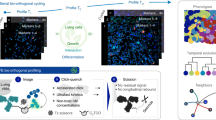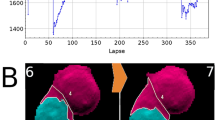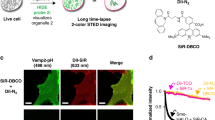Abstract
Luminescent quantum dots (QDs)—semiconductor nanocrystals—are a promising alternative to organic dyes for fluorescence-based applications. We have developed procedures for using QDs to label live cells and have demonstrated their use for long-term multicolor imaging of live cells. The two approaches presented are (i) endocytic uptake of QDs and (ii) selective labeling of cell surface proteins with QDs conjugated to antibodies. Live cells labeled using these approaches were used for long-term multicolor imaging. The cells remained stably labeled for over a week as they grew and developed. These approaches should permit the simultaneous study of multiple cells over long periods of time as they proceed through growth and development.
This is a preview of subscription content, access via your institution
Access options
Subscribe to this journal
Receive 12 print issues and online access
$209.00 per year
only $17.42 per issue
Buy this article
- Purchase on Springer Link
- Instant access to full article PDF
Prices may be subject to local taxes which are calculated during checkout






Similar content being viewed by others
References
Finley, K.R., Davidson, A.E. & Ekker, S.C. Three-color imaging using fluorescent proteins in living zebrafish embryos. Biotechniques 31, 66–72 (2001).
Giuliano, K.A., Post, P.L., Hahn, K.M. & Taylor, D.L. Fluorescent protein biosensors: measurement of molecular dynamics in living cells. Annu. Rev. Biophys. Biomol. Struct. 24, 405–434 (1995).
Johnson, I. Fluorescent probes for living cells. Histochem. J. 30, 123–140 (1998).
Bruchez, M., Jr., Moronne, M., Gin, P., Weiss, S. & Alivisatos, A.P. Semiconductor nanocrystals as fluorescent biological labels. Science 281, 2013–2016 (1998).
Mattoussi, H., Kuno, M.K., Goldman, E.R., George, P. & Mauro, J.M. in Optical Biosensors: Present and Future (eds. Ligler, F.S. & Rowe, C.A.) 537–569 (Elsevier, The Netherlands, 2002).
Mattoussi, H. et al. Self-assembly of CdSe-ZnS quantum dot bioconjugates using an engineered recombinant protein. J. Am. Chem. Soc. 122, 12142–12150 (2000).
Han, M., Gao, X., Su, J.Z. & Nie, S. Quantum-dot-tagged microbeads for multiplexed optical coding of biomolecules. Nat. Biotechnol. 19, 631–635 (2001).
Michalet, X. et al. Properties of fluorescent semiconductor nanocrystals and their application to biological labeling. Single Molec. 2, 261–276 (2001).
Chan, W.C., Maxwell, D.J., Gao, X., Bailey, R.E., Han, M. & Nie, S. Luminescent quantum dots for multiplexed biological detection and imaging. Curr. Opin. Biotechnol. 13, 40–46 (2002).
Mattoussi, H. et al. Bioconjugation of highly luminescent colloidal CdSe-ZnS quantum dots with an engineered two-domain recombinant protein. Phys. Stat. Sol. 224, 277–283 (2001).
Goldman, E.R. et al. Avidin: a natural bridge for quantum dot-antibody conjugates. J. Am. Chem. Soc. 124, 6378–6382 (2002).
Chan, W.C. & Nie, S. Quantum dot bioconjugates for ultrasensitive nonisotopic detection. Science 281, 2016–2018 (1998).
Goldman, E.R., Anderson, G.P., Tran, P.T., Mattoussi, H., Charles, P.T. & Mauro, J.M. Conjugation of luminescent quantum dots with antibodies using an engineered adaptor protein to provide new reagents for fluoroimmunoassays. Anal. Chem. 74, 841–847 (2002).
Adamson, P., Paterson, H.F. & Hall, A. Intracellular localization of the P21rho proteins. J. Cell Biol. 119, 617–627 (1992).
Tomchik, K.J. & Devreotes, P.N. Adenosine 3',5′-monophosphate waves in Dictyostelium discoideum: a demonstration by isotope dilution-fluorography. Science 212, 443–446 (1981).
Parent, C.A. & Devreotes, P.N. Molecular genetics of signal transduction in Dictyostelium. Annu. Rev. Biochem. 65, 411–440 (1996).
Gerisch, G. & Wick, U. Intracellular oscillations and release of cyclic AMP from Dictyostelium cells. Biochem. Biophys. Res. Commun. 65, 364–370 (1975).
Chen, Y. & Simon, S.M. In situ biochemical demonstration that P-glycoprotein is a drug efflux pump with broad specificity. J. Cell Biol. 148, 863–870 (2000).
Rodrigez-Viejo, J. et al. Evidence of photo- and electrodarkening of (CdSe)ZnS quantum dot composites. J. Appl. Phys. 87, 8526–8534 (2000).
Waddell, D.R. The spatial pattern of aggregation centres in the cellular slime mould. J. Embryol. Exp. Morphol. 70, 75–98 (1982).
Robertson, A. & Cohen, M.H. Control of developing fields. Ann. Rev. Biophys. Bioeng. 1, 409–464 (1972).
Watts, D.J. & Ashworth, J.M. Growth of myxamoebae of the cellular slime mould Dictyostelium discoideum in axenic culture. Biochem. J. 119, 171–174 (1970).
De Souza, N.F. & Simon, S.M. Glycosylation affects the rate of traffic of the shaker potassium channel through the secretory pathway. Biochemistry 41, 11351–11361 (2002).
Acknowledgements
We thank Tom Donley, Ellen Goldman, George Anderson, Evelyn Voura, and Collin Thomas for their help and suggestions during the course of this work. J.K.J. and S.M.S. acknowledge financial support by the grants NSF BES 0110070 and NSF BES 0119468 to S.M.S. H.M. and J.M.M. acknowledge Dr. K. Ward at the Office of Naval Research (ONR) for research support, and grants # N0001499WX30470 and # N0001400WX20094 for financial support. The views, opinions, and findings described in this report are those of the authors and should not be construed as official Department of the Navy positions, policies or decisions.
Author information
Authors and Affiliations
Corresponding author
Ethics declarations
Competing interests
The authors declare no competing financial interests.
Rights and permissions
About this article
Cite this article
Jaiswal, J., Mattoussi, H., Mauro, J. et al. Long-term multiple color imaging of live cells using quantum dot bioconjugates. Nat Biotechnol 21, 47–51 (2003). https://doi.org/10.1038/nbt767
Received:
Accepted:
Published:
Issue Date:
DOI: https://doi.org/10.1038/nbt767
This article is cited by
-
Quantum-dot-labeled synuclein seed assay identifies drugs modulating the experimental prion-like transmission
Communications Biology (2022)
-
Grass-derived carbon nanodots as a fluorescent-sensing platform for label-free detection of Cu (II) ions
Journal of Materials Science: Materials in Electronics (2022)



